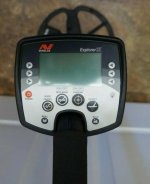......Enough said, time for some POSITIVE advice from you Explorer/eTrac users. Thanks!
Had my Explorer for 10 years and have never used the numbers, always the smart find w/cursor. One of the reasons I really don’t care for my Etrac, the VDI feature.
I picked up a used Explorer 2 with the stock 1050 (10.5") coil at the start of the month just to see what's the fuss, and also see if I can crack back open a permission that's drying up as far as silver goes. I'll save some observations until the end of the month.
Regarding numbers versus cursor, I'm leaning towards the numbers. No matter what, it's always listen first and check numbers second.
What I've been going by so far are a few general rules I created based on different charts I've seen and what I've seen myself so far in the field and some initial backyard testing with various coin and common trash targets. I've listed them below. As I get better with it I'm sure I'll develop some more exceptions and nuances to the rules, and develop my ear for them.
To start, I'm using the default coin pattern. I increase manual sensitivity until it becomes unstable or I hear EMI null out the threshold tone. Noise cancel. Adjust sensitivity again, and then back off 2-3 steps below what was barely stable. I use iron mask as needed set a couple of clicks more open than the default.
Starting Rule #1 (Silver, high conductor coins, avoiding bottle caps)
Dig everything with conductivity 24+ and Ferrous 5 and under as long as it passes basic tests of size, shape, depth, etc.. If the Ferrous is 6 or 7, it must pass those tests and preferably also have an ascending musical tone rather than a flat or broken tone.
Starting Rule #2 (Nickels)
Dig Conductivity 5, 6, 7. Again, must pass basic tests of size, shape, depth, and quality of tone.
Starting rule #3 (Rings, relics, avoiding pull tabs)
If I hear a tone I like that doesn't fit rules 1 and 2, but has ferrous 12 and under, then dig it unless it's any pair combination of 8s, 9s, or 10s. No 8-8, 9-9, 10-10, 8-9, 8-10, 9-8, 9-10, 10-8, 10-9.
Out of two hunts so far I've dug two deep silver and about 10 wheat pennies on the property, and very, very little trash dug other than what's in the hole with the coin.



 My advice, turn it on, noise cancel, and have fun! I would maybe throw a few coins from your pocket on the ground, just to get an idea of how a coin should sound. When you go over silver, that machine will sing to you! If I had to explain the sound it's almost "flutey" when it hits silver. I would worry about switching settings after using it for awhile, but even then, the factory settings are more than capable of the finding the goods. Good luck out there, and keep us posted!
My advice, turn it on, noise cancel, and have fun! I would maybe throw a few coins from your pocket on the ground, just to get an idea of how a coin should sound. When you go over silver, that machine will sing to you! If I had to explain the sound it's almost "flutey" when it hits silver. I would worry about switching settings after using it for awhile, but even then, the factory settings are more than capable of the finding the goods. Good luck out there, and keep us posted!




